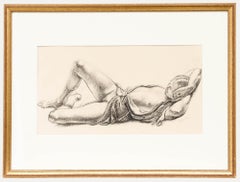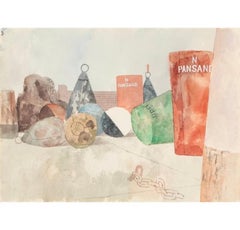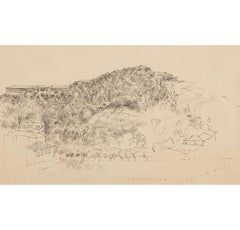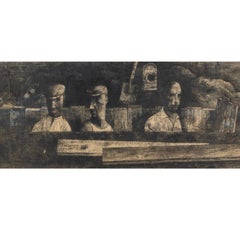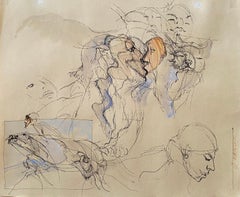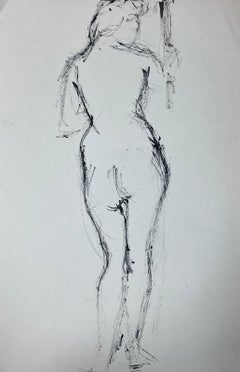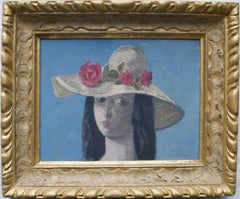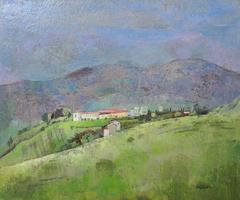Reginald Brill Art
to
2
1
2
Overall Width
to
Overall Height
to
5
5
3
2
1
1
1
1
4
1
1
5
10,083
2,772
1,380
1,375
5
5
Artist: Reginald Brill
Reginald Brill (1902-1974) - 1931 Pen and Ink Drawing, Reclining Nude
By Reginald Brill
Located in Corsham, GB
A striking ink study by the artist Reginald Brill (1902-1974) depicting a reclining nude lady. The artist expertly uses hatching to create this wonderfully tonal piece and captures t...
Category
Early 20th Century Reginald Brill Art
Materials
Pen
Italian Scene, Pen and Ink with Wash Painting by Reginald Brill, 1950s circa
By Reginald Brill
Located in Kingsclere, GB
Italian Scene, Pen and Ink with Wash Painting by Reginald Brill, 1950s circa
Additional information:
Medium: Pen and ink with wash
33 x 48.3 cm
13 x 19 in
Reginald " Reggie" Brill was a versastile 20th century artist and teacher.
Brill was born in London in 1902 and spent his early childhood there and in Yorkshire. By the time of the First World War, at the age of 13, he was living in lodgings in London, working in a City office and attending St Martins School of Art in the evenings. Considering his lack of education, winning a scholarship to The Slade (now part of University College London) in 1921 where he studied under Henry Tonks for three years, was a huge achievement.
On leaving The Slade he found patronage in Lincolnshire, but by the time of the General Strike (1926) he had returned to London and was working on Lansbury's Labour Weekly. He married Rosalie, also an artist, and in 1927 won the Prix de Rome in Decorative Painting. Following two years at The British School in Rome, Brill went to teach at Blackheath School of Art. During 1930 he spent three months painting in Egypt and it was there that he met Col. T G Gayer-Anderson, one of the twin brothers who were to bequeath The Little Hall in Lavenham as a hostel for art students. It was there that Brill retired to act as warden, thus continuing his nurturing of art students until his death in 1972.
Brill took up his appointment at The School of Art, Kingston upon Thames in January 1934. It was situated in the Technical Institute (Kingston Hall Road) and Brill found it bohemian and disorganised. He proceeded to inject enthusiasm, order and discipline. Within 5 years of his appointment a purpose-built School of Art was opened in Knights Park. It remained open throughout the war and by 1945 there was a waiting list for places. Under the skilled and totally dedicated direction of Brill, Kingston School of Art became established with national reputation for excellence. In 1961 Sir Charles Wheeler opened the new building at Knights Park. Costing £100,000, this more than doubled the size of the Art School.
Brill, was a well-known figure in Kingston. His eloquence made him popular as a guest speaker and his promotion of Art and Design stretched well beyond the doors of Knights Park. Apart from establishing two of the main buildings which makeup what is now known as the Faculty of Design, one of the most visible local contributions he made was the setting up of a topographical collection of paintings depicting Kingston, which has since become known as The Brill Collection at Kingston Museum. Brill gained huge respect and admiration from the hundreds of pupils who studied at Kingston during his 30-year leadership.
He published two books, Modern Painting 1946 and Art as a Career 1962, both bearing a strong educational angle. He regularly exhibited along with leading artists of his era at The Royal Academy, both his paintings and his acutely observed drawings. All the while he was a prolific artist, although reading his diaries, intensely self-critical. His perfectionism, acute powers of observation and relentless research can be seen in his drawings, which via the media and methods he explored throughout his life reflect mid 20th century British Art at its most typical. His major series of work, known as 'The Martyrdom of Man', was carried on in parallel to his career as a teacher. These paintings reflect his care for fellow man and depict people at work, e.g., The Operation, The Jury, Linemen, Waiting Room and Rest, which recently sold at Sotheby’s and was specially restored for The Brill Retrospective. His smaller works also play with the theme of everyday events and communication amongst people, such as The Bull Ring and Market Place paintings.
Brill's name is associated particularly with human figure compositions, but he also worked on landscapes, portraits and details of plants, animals, interiors etc. As one would expect he moved from one media to another, and his unusual hand painted and cut paper mosaics...
Category
20th Century Reginald Brill Art
Materials
Pen
Buoys No.3, Watercolour Painting by Reginald Brill
By Reginald Brill
Located in Kingsclere, GB
Buoys No.3, Watercolour Painting by Reginald Brill
Additional information:
Medium: Watercolour
24 x 34 cm
9 1/2 x 13 3/8 in
Titled verso
This is part of a group of keenly observed ...
Category
20th Century Reginald Brill Art
Materials
Watercolor
Italian Landscape, Pen Painting by Reginald Brill, 1950 circa
By Reginald Brill
Located in Kingsclere, GB
Italian Landscape, Pen Painting by Reginald Brill, 1950 circa
Additional information:
Medium: Ink
20 x 34 cm
7 7/8 x 13 3/8 in
Reginald " Reggie" Brill was a versastile 20th century artist and teacher.
Brill was born in London in 1902 and spent his early childhood there and in Yorkshire. By the time of the First World War, at the age of 13, he was living in lodgings in London, working in a City office and attending St Martins School of Art in the evenings. Considering his lack of education, winning a scholarship to The Slade (now part of University College London) in 1921 where he studied under Henry Tonks for three years, was a huge achievement.
On leaving The Slade he found patronage in Lincolnshire, but by the time of the General Strike (1926) he had returned to London and was working on Lansbury's Labour Weekly. He married Rosalie, also an artist, and in 1927 won the Prix de Rome in Decorative Painting. Following two years at The British School in Rome, Brill went to teach at Blackheath School of Art. During 1930 he spent three months painting in Egypt and it was there that he met Col. T G Gayer-Anderson, one of the twin brothers who were to bequeath The Little Hall in Lavenham as a hostel for art students. It was there that Brill retired to act as warden, thus continuing his nurturing of art students until his death in 1972.
Brill took up his appointment at The School of Art, Kingston upon Thames in January 1934. It was situated in the Technical Institute (Kingston Hall Road) and Brill found it bohemian and disorganised. He proceeded to inject enthusiasm, order and discipline. Within 5 years of his appointment a purpose-built School of Art was opened in Knights Park. It remained open throughout the war and by 1945 there was a waiting list for places. Under the skilled and totally dedicated direction of Brill, Kingston School of Art became established with national reputation for excellence. In 1961 Sir Charles Wheeler opened the new building at Knights Park. Costing £100,000, this more than doubled the size of the Art School.
Brill, was a well-known figure in Kingston. His eloquence made him popular as a guest speaker and his promotion of Art and Design stretched well beyond the doors of Knights Park. Apart from establishing two of the main buildings which makeup what is now known as the Faculty of Design, one of the most visible local contributions he made was the setting up of a topographical collection of paintings depicting Kingston, which has since become known as The Brill Collection at Kingston Museum. Brill gained huge respect and admiration from the hundreds of pupils who studied at Kingston during his 30-year leadership.
He published two books, Modern Painting 1946 and Art as a Career 1962, both bearing a strong educational angle. He regularly exhibited along with leading artists of his era at The Royal Academy, both his paintings and his acutely observed drawings. All the while he was a prolific artist, although reading his diaries, intensely self-critical. His perfectionism, acute powers of observation and relentless research can be seen in his drawings, which via the media and methods he explored throughout his life reflect mid 20th century British Art at its most typical. His major series of work, known as 'The Martyrdom of Man', was carried on in parallel to his career as a teacher. These paintings reflect his care for fellow man and depict people at work, e.g., The Operation, The Jury, Linemen, Waiting Room and Rest, which recently sold at Sotheby’s and was specially restored for The Brill Retrospective. His smaller works also play with the theme of everyday events and communication amongst people, such as The Bull Ring and Market Place paintings.
Brill's name is associated particularly with human figure compositions, but he also worked on landscapes, portraits and details of plants, animals, interiors etc. As one would expect he moved from one media to another, and his unusual hand painted and cut paper mosaics...
Category
20th Century Reginald Brill Art
Materials
Pen
Study for Men in the Trench, Pen, Ink & Watercolour on Paper Painting 1950 circa
By Reginald Brill
Located in Kingsclere, GB
Study for Men in the Trench, Pen, Ink & Watercolour on Paper Painting 1950 circa
Additional information:
Medium: Pen, ink and watercolour on paper
11 3/4 x 26 in
29.8 x 68.5 cm
Reginald " Reggie" Brill was a versastile 20th century artist and teacher.
Brill was born in London in 1902 and spent his early childhood there and in Yorkshire. By the time of the First World War, at the age of 13, he was living in lodgings in London, working in a City office and attending St Martins School of Art in the evenings. Considering his lack of education, winning a scholarship to The Slade (now part of University College London) in 1921 where he studied under Henry Tonks for three years, was a huge achievement.
On leaving The Slade he found patronage in Lincolnshire, but by the time of the General Strike (1926) he had returned to London and was working on Lansbury's Labour Weekly. He married Rosalie, also an artist, and in 1927 won the Prix de Rome in Decorative Painting. Following two years at The British School in Rome, Brill went to teach at Blackheath School of Art. During 1930 he spent three months painting in Egypt and it was there that he met Col. T G Gayer-Anderson, one of the twin brothers who were to bequeath The Little Hall in Lavenham as a hostel for art students. It was there that Brill retired to act as warden, thus continuing his nurturing of art students until his death in 1972.
Brill took up his appointment at The School of Art, Kingston upon Thames in January 1934. It was situated in the Technical Institute (Kingston Hall Road) and Brill found it bohemian and disorganised. He proceeded to inject enthusiasm, order and discipline. Within 5 years of his appointment a purpose-built School of Art was opened in Knights Park. It remained open throughout the war and by 1945 there was a waiting list for places. Under the skilled and totally dedicated direction of Brill, Kingston School of Art became established with national reputation for excellence. In 1961 Sir Charles Wheeler opened the new building at Knights Park. Costing £100,000, this more than doubled the size of the Art School.
Brill, was a well-known figure in Kingston. His eloquence made him popular as a guest speaker and his promotion of Art and Design stretched well beyond the doors of Knights Park. Apart from establishing two of the main buildings which makeup what is now known as the Faculty of Design, one of the most visible local contributions he made was the setting up of a topographical collection of paintings depicting Kingston, which has since become known as The Brill Collection at Kingston Museum. Brill gained huge respect and admiration from the hundreds of pupils who studied at Kingston during his 30-year leadership.
He published two books, Modern Painting 1946 and Art as a Career 1962, both bearing a strong educational angle. He regularly exhibited along with leading artists of his era at The Royal Academy, both his paintings and his acutely observed drawings. All the while he was a prolific artist, although reading his diaries, intensely self-critical. His perfectionism, acute powers of observation and relentless research can be seen in his drawings, which via the media and methods he explored throughout his life reflect mid 20th century British Art at its most typical. His major series of work, known as 'The Martyrdom of Man', was carried on in parallel to his career as a teacher. These paintings reflect his care for fellow man and depict people at work, e.g., The Operation, The Jury, Linemen, Waiting Room and Rest, which recently sold at Sotheby’s and was specially restored for The Brill Retrospective. His smaller works also play with the theme of everyday events and communication amongst people, such as The Bull Ring and Market Place paintings.
Brill's name is associated particularly with human figure compositions, but he also worked on landscapes, portraits and details of plants, animals, interiors etc. As one would expect he moved from one media to another, and his unusual hand painted and cut paper mosaics...
Category
20th Century Reginald Brill Art
Materials
Pen
Related Items
“Animals and Figures”
Located in Southampton, NY
Original pen and black ink drawing with watercolor wash in specific areas. Study of figures and animals intertwined. Signed vertically right side along with the artist’s initials lower right. The artwork is tabbed on top two corners to a heavy card backing. Circa 1965. Condition is good to very good. Under UV plexiglass. Framed in a contemporary silver gallery frame. Overall framed measurements are 16.5 by 19 inches. Provenance: A Sarasota, Florida estate.
Craig Rubadoux...
Category
1960s Post-Modern Reginald Brill Art
Materials
Paper, Ink, Watercolor, Pen
French Expressive Charcoal Sketch of a Standing Nude Figure
Located in Cirencester, Gloucestershire
Standing Nude Figure
black pen drawing on artist paper
painting: 13.75 x 9 inches
provenance: private collection, England
condition: very good and sound condition
Category
20th Century Impressionist Reginald Brill Art
Materials
Ballpoint Pen
$150
H 13.75 in W 9 in D 1 in
Nude in Negligee /// Contemporary Female Lesbian LGBT Figurative Women Artists
By Emilia Castaneda
Located in Saint Augustine, FL
Artist: Emilia Castañeda (Spanish, 1943-)
Title: "Nude in Negligee"
*Signed by Castaneda in pencil lower right
Circa: 1980
Medium: Original Pen & Ink and Watercolor Drawing on wove p...
Category
1980s Contemporary Reginald Brill Art
Materials
Ink, Watercolor, Pen
French Pen & Ink - Artist's Muse
By Jean-Baptiste Grancher
Located in Houston, TX
Black and white pen & ink drawing of a nude female model posing for an artist by French artist Jean Baptiste Grancher, circa 1950.
Original artwork on paper displayed on a white mat...
Category
1950s Reginald Brill Art
Materials
Ink, Paper, Pen
Charles Levier [Les Voiles au Repos] c. 1970 Hand Signed Watercolor Harbor Scene
By Charles Levier
Located in Miami, FL
CHARLES LEVIER – [LES VOILES AU REPOS]
⚜ Watercolor on paper ⚜ Hand signed lower right ⚜ Custom frame
HARBORFRONT CALM WITH DOCKED SAILS
Levier captures a quiet quay where fishing b...
Category
1970s Post-Impressionist Reginald Brill Art
Materials
Paper, Mixed Media, Watercolor
$3,500
H 26 in W 33.125 in D 1.125 in
ABSTRACT FORCES
By Angel Rivas
Located in CÓRDOBA, ES
Acrylic on canvas
Shipped rolled in a tube
100% hand made painting, unique piece.
Category
2010s Post-Modern Reginald Brill Art
Materials
Acrylic, Permanent Marker
Nu tenant un miroir by Pablo Picasso
By Pablo Picasso
Located in New Orleans, LA
Pablo Picasso
1881-1973 Spanish
Nu tenant un miroir
(Nude holding a mirror)
Signed "Picasso" (lower right)
Pen and ink on paper
Pablo Picasso's Rose Period is among the most icon...
Category
Early 20th Century Reginald Brill Art
Materials
Paper, Ink, Pen
Making Love Series I, Nude Drawing, Pen & Ink Paper Pasted on Board "In Stock"
By Sunil Das
Located in Kolkata, West Bengal
Sunil Das - Making Love Series I - 9 x 7 inches (unframed size)
Pen and Ink on Paper Pasted on Board
Shipment without frame .
Sunil Das (1939-2015) was a Master Modern Indian Artist...
Category
2010s Modern Reginald Brill Art
Materials
Paper, Ink, Pen, Board
$960 Sale Price
20% Off
H 17 in W 15 in D 1 in
Early 19th Century English watercolour of woodland near Croxdale Hall
Located in Harkstead, GB
A very attractive and meticulously executed view of a rocky landscape within the woods dating to 1823. This would suit a library or study with its muted tones and skifull draughtsmanship.
William Nicholson (1781-1844)
Near Croxdale Hall
Signed with initials and inscribed with title and date 1823
Pen, ink and grey wash
11 x 8 inches, image only
17 x 13 inches without frame
The portrait-painter and etcher William Nicholson was born in Ovingham-on-Tyne, Northumberland, on Christmas Day 1781. His family transferred to Newcastle when his father was appointed Headmaster of the city's Grammar School. At an early age, though, Nicholson appears to have moved to Hull where he made his artistic debut, painting miniatures of officers garrisoned there. He was almost entirely self-taught, learning his craft through the close study of artworks in private and public galleries. He subsequently returned to Newcastle where he received many commissions to paint portraits of the old families of Northumberland. In 1808, he began to exhibit at the Royal Academy, continuing to do so until 1822. By 1814, Nicholson, whose mother was a Scot, had moved to Edinburgh where he set up as a miniaturist and painter in oils. Soon, however, he began to specialize in watercolour portraits. Early subjects included the actor Daniel Terry and the poet and novelist James Hogg. In 1818 he began to publish a series of Portraits of Eminent Scotsmen, etched from his own portraits and those of other painters. Besides Scott and Hogg, the subjects included the writers Robert Burns, John Wilson ('Christopher North'), and Lord Jeffrey, the painters Sir Henry Raeburn, the divines Alexander Carlyle and Alexander Cameron, the engineer James Watt, the architect John Playfair, and the song-collector and composer George Thomson...
Category
Early 19th Century Academic Reginald Brill Art
Materials
Paper, Watercolor, Ink, Pen
$410 Sale Price
20% Off
H 11 in W 8 in D 1 in
SUMMER DAYS
Located in CÓRDOBA, ES
Emerging young artist with a very personal and recognizable style.
Without a doubt he will have a long journey and a great progression in her artistic career.
Acrylic on canvas
Ship...
Category
2010s Post-Modern Reginald Brill Art
Materials
Oil, Acrylic, Permanent Marker
Untitled, 1980, gouache on paper
Located in PARIS, FR
Andrée HONOREE (1945-1992)
Untitled, 1980
Gouache on paper
Signed and dated "1980" lower center
43 x 31.5 cm
Born in 1945 in Tourcoing, Andrée Honoré is one of the women sculptors who have chosen wood as their main medium. For a time, she had a studio in the Passage Ricaut in the 13th arrondissement of Paris, where she worked alongside the artists Jacques Hérold (1901-1987), Edgard Pillet...
Category
1980s Abstract Reginald Brill Art
Materials
Gouache
OPEN EYE
Located in CÓRDOBA, ES
Emerging young artist with a very personal and recognizable style.
Without a doubt he will have a long journey and a great progression in her artistic career.
Acrylic on canvas
Ship...
Category
2010s Post-Modern Reginald Brill Art
Materials
Oil, Acrylic, Permanent Marker
Previously Available Items
Reginald Brill, The Sun hat, Modern British oil portrait of a young lady
By Reginald Brill
Located in Harkstead, GB
Reginald Brill (1902-1974)
The Sun hat,
Signed,
Oil on board,
9 x 12 inches.
14 x 17 inches with frame
Exhibited: The Phoenix Gallery, Lavenham, Suffolk, 1975.
Provenance: Privat...
Category
Mid-20th Century Modern Reginald Brill Art
Materials
Oil, Board
Italian hilltop town
By Reginald Brill
Located in Sutton Poyntz, Dorset
This original oil painting by Reginald Brill, dating from around 1950s, is presented and supplied in its original frame that has been redressed and freshened with colouring to suit t...
Category
Mid-20th Century Modern Reginald Brill Art
Materials
Canvas, Oil
Reginald Brill art for sale on 1stDibs.
Find a wide variety of authentic Reginald Brill art available for sale on 1stDibs. Customers who are interested in this artist might also find the work of Philip Gilbert Hamerton, John Wilkes, and Jonathan Chritchley.
